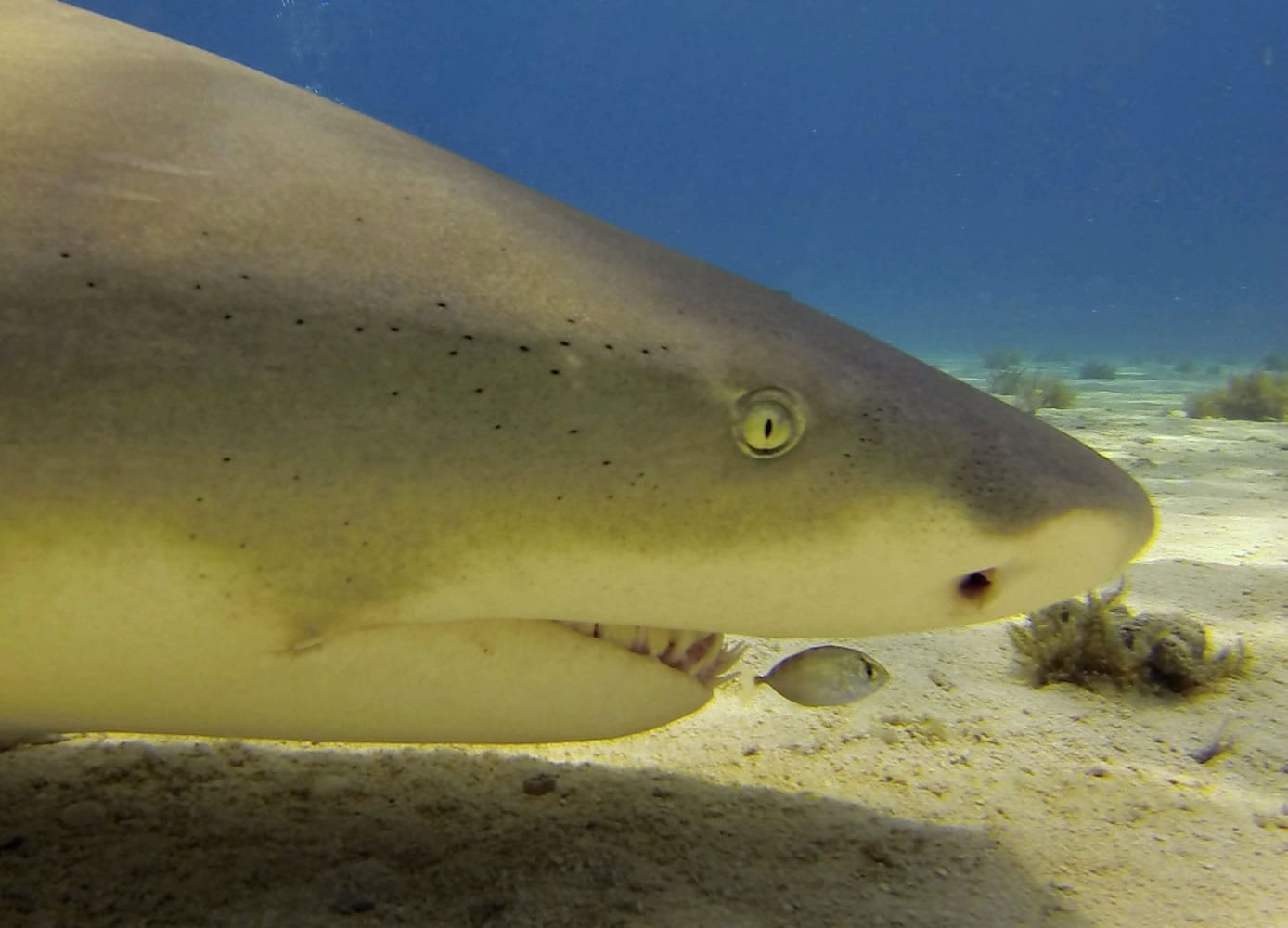The Carib Dancer is one of the Aggressor Fleet & Dancer Fleet diving yachts traveling to as many as 15 scuba destinations around the world — from Belize to Thailand to the Galapagos Islands and elsewhere. We boarded the Carib Dancer after a direct and very easy flight from Charlotte, N.C., to Freeport, Bahamas.
The Carib Dancer is a 100-foot live-aboard normally working out of Nassau. The dive yacht is equipped for as many as 14 divers, who make as many as five dives each day, including night dives. The beauty of live-aboard diving is that you get in a lot of diving, and at remote sites that aren’t accessible from land-based operations.
The Carib Dancer breaks away from Bahamas reef diving as many as three weeks each summer to take shark enthusiasts to the rarely visited Tiger Beach area, off the West End of Grand Bahama Island. Details: www.aggressor.com.
Sharks.
We splashed into the clear waters off Grand Bahama Island and immediately saw what we came to see: Lots of them. We were nose-to-nose with them. They were so plentiful that we encountered them on each of our 17 dives — as many as 20 on a single dive. In fact, we saw more sharks than people on remote reefs and shoals.
The Carib Dancer is one of the Aggressor Fleet & Dancer Fleet diving yachts traveling to as many as 15 scuba destinations around the world -- from Belize to Thailand to the Galapagos Islands and elsewhere. We boarded the Carib Dancer after a direct and very easy flight from Charlotte, N.C., to Freeport, Bahamas.
The Carib Dancer is a 100-foot live-aboard normally working out of Nassau. The dive yacht is equipped for as many as 14 divers, who make as many as five dives each day, including night dives. The beauty of live-aboard diving is that you get in a lot of diving, and at remote sites that aren't accessible from land-based operations.
The Carib Dancer breaks away from Bahamas reef diving as many as three weeks each summer to take shark enthusiasts to the rarely visited Tiger Beach area, off the West End of Grand Bahama Island. Details: <a href="http://www.aggressor.com.">www.aggressor.com.</a>
There were high-action dives with nurse, lemon and Caribbean reef sharks. And some of them got very cozy. The six-day trip also included dives down to a 100-year-old molasses barge called the Sugar Wreck, as well as exceptional night dives.
We also had beautiful encounters on the reefs with a variety of critters such as loggerhead and hawksbill sea turtles, trumpetfish, invasive lionfish, angelfish, snappers and grunts.
Our first dive on the Sugar Wreck was among my favorite dives ever. It was a shallow dive, 25 feet down, that allowed us to enjoy this fabulous old wreck for about 90 minutes. We had beautiful light, hawksbill turtles, nurse sharks, hundreds of grunts and snapper, a white-sand bottom off the wreck and an easy current. This is classic tropical diving.
After a few extraordinary dives on the Sugar Wreck, we were off to find what we came for: tiger sharks. Our first spot was a remote sand shoal called Tiger Beach. We were not lucky enough to find tigers. But we did encounter other sharks, mostly lemon. We never felt threatened, but the many large sharks did get a bit frisky. They bumped some of us with their fins or noses and pulled on our fins. One diver had a small toy dangling from her air tank; a shark snatched it, put it in its mouth and then coughed it back out.
We spent hours with these sleek and beautiful predators but we also longed for diversity.
The night diving was spectacular and another exhilarating way to experience the reef. Night is when the beautiful and bizarre creatures emerge. And Sugar Wreck looked like a completely different place after dark. The countless number of fish including porcupines and nurse sharks; there were also huge loggerhead and hawksbill turtles, prehistoric-looking slipper lobsters and a gaudy, spotted Caribbean lobster.
We stopped at several other spectacular spots, including Shark Paradise reef, where we found several lively and curious Caribbean reef sharks that had no fear of us. They bumped us to understand the odd intruders.
El Capitan was a drift dive at 89 feet, probably the deepest dive of the week. It was my least favorite. We wound up soaring 30 feet above the reef, trying to keep the group together in hauling current.
Mini Wall was a gorgeous pair of parallel reefs with a 80-foot-deep sand channel between. The first tops out in about 30 feet of water, then you cross the sand to the second reef, topping out at about 60 feet. The landscape of the reef at times towered above the divers. Many of us were surprised when an extremely large and curious lemon shark suddenly appeared out of the darkness and within feet of us.
The aptly named Hogfish Reef was home to many Spanish hogfish and several large Caribbean reef sharks, trumpetfish and angels. It was another spot of nice topography with a lot of relief and sand edge.
Then it was back to Tiger Beach where the lemons were getting more familiar. Their growing comfort with our presence let us see some extraordinary behavior up close. One lemon seemed to tolerate, if not simply ignore, my close approach as it lay on the sand. It opened its formidable mouth wide and waited while an 8-inch remora swam in and out, cleaning around and between the serrated teeth.
We ended the trip with another breathtaking night dive on the wreck where we began our adventure. There were more huge loggerheads and one was being constantly harassed by a pair of large remoras. Finally, the turtle squeezed beneath some steel plates of the wreck to force them off, and we headed for the last time to the dive ladders. Our logbooks were rapidly filling with once-in-a-lifetime adventures.



